Pacing Strategy of 800 m and 1500 m Freestyle Swimming Finals in the World Championships According to the Performance in Males and Females of Different Age Groups
Abstract
1. Introduction
2. Materials and Methods
2.1. Data Analysis
2.2. Variables Analysed
2.3. Statistical Analysis
3. Results
4. Discussion
5. Conclusions
Author Contributions
Funding
Institutional Review Board Statement
Informed Consent Statement
Data Availability Statement
Conflicts of Interest
References
- Menting, S.G.P.; Hendry, D.T.; Schiphof-Godart, L.; Elferink-Gemser, M.T.; Hettinga, F.J. Optimal Development of Youth Athletes Toward Elite Athletic Performance: How to Coach Their Motivation, Plan Exercise Training, and Pace the Race. Front. Sports Act. Living 2019, 1, 14. [Google Scholar] [CrossRef] [PubMed]
- McGibbon, K.E.; Shephard, M.E.; Osborne, M.A.; Thompson, K.G.; Pyne, D.B. Pacing and Performance in Swimming: Differences Between Individual and Relay Events. Int. J. Sports Physiol. Perform. 2020, 15, 1059–1066. [Google Scholar] [CrossRef] [PubMed]
- Menting, S.G.P.; Elferink-Gemser, M.T.; Huijgen, B.C.; Hettinga, F.J. Pacing in Lane-Based Head-to-Head Competitions: A Systematic Review on Swimming. J. Sports Sci. 2019, 37, 2287–2299. [Google Scholar] [CrossRef] [PubMed]
- Menting, S.G.P.; Post, A.K.; Nijenhuis, S.B.; Koning, R.H.; Visscher, C.; Hettinga, F.J.; Elferink-Gemser, M.T. Pacing Behavior Development in Adolescent Swimmers: A Large-Scale Longitudinal Data Analysis. Med. Sci. Sports Exerc. 2023, 55, 700–709. [Google Scholar] [CrossRef] [PubMed]
- McGibbon, K.E.; Pyne, D.B.; Shephard, M.E.; Thompson, K.G. Pacing in Swimming: A Systematic Review. Sports Med. 2018, 48, 1621–1633. [Google Scholar] [CrossRef] [PubMed]
- Gonjo, T.; Olstad, B.H. Race Analysis in Competitive Swimming: A Narrative Review. Int. J. Environ. Res. Public Health 2020, 18, 69. [Google Scholar] [CrossRef] [PubMed]
- Oliveira, G.T.D.; Werneck, F.Z.; Coelho, E.F.; Simim, M.A.D.M.; Penna, E.M.; Ferreira, R.M. What Pacing Strategy 800m and 1500m Swimmers Use? Rev. Bras. Cineantropometria Desempenho Hum. 2019, 21, e59851. [Google Scholar] [CrossRef]
- Neuloh, J.E.; Skorski, S.; Mauger, L.; Hecksteden, A.; Meyer, T. Analysis of End-Spurt Behaviour in Elite 800-m and 1500-m Freestyle Swimming. Eur. J. Sport Sci. 2021, 21, 1628–1636. [Google Scholar] [CrossRef]
- Demarie, S.; Pycke, J.R.; Pizzuti, A.; Billat, V. Pacing of Human Locomotion on Land and in Water: 1500 m Swimming vs. 5000 m Running. Appl. Sci. 2023, 13, 6455. [Google Scholar] [CrossRef]
- Casado, A.; Hanley, B.; Jiménez-Reyes, P.; Renfree, A. Pacing Profiles and Tactical Behaviors of Elite Runners. J. Sport Health Sci. 2021, 10, 537–549. [Google Scholar] [CrossRef]
- Abbiss, C.R.; Laursen, P.B. Describing and Understanding Pacing Strategies during Athletic Competition. Sports Med. 2008, 38, 239–252. [Google Scholar] [CrossRef] [PubMed]
- Veiga, S.; Rodriguez, L.; González-Frutos, P.; Navandar, A. Race Strategies of Open Water Swimmers in the 5-Km, 10-Km, and 25-Km Races of the 2017 FINA World Swimming Championships. Front. Psychol. 2019, 10, 654. [Google Scholar] [CrossRef] [PubMed]
- Da Silva, J.K.F. Analysis of the Performance of Finalist Swimming Athletes in Olympic Games: Reaction Time, Partial Time, Speed, and Final Time. J. Phys. Educ. Sport 2020, 20, 539–545. [Google Scholar] [CrossRef]
- Lipinska, P.; Allen, S.V.; Hopkins, W.G. Relationships Between Pacing Parameters and Performance of Elite Male 1500-m Swimmers. Int. J. Sports Physiol. Perform. 2016, 11, 159–163. [Google Scholar] [CrossRef] [PubMed]
- Tucker, R.; Noakes, T.D. The Physiological Regulation of Pacing Strategy during Exercise: A Critical Review. Br. J. Sports Med. 2009, 43, e1. [Google Scholar] [CrossRef] [PubMed]
- Foster, C.; Hendrickson, K.J.; Peyer, K.; Reiner, B.; deKoning, J.J.; Lucia, A.; Battista, R.A.; Hettinga, F.J.; Porcari, J.P.; Wright, G. Pattern of Developing the Performance Template. Br. J. Sports Med. 2009, 43, 765–769. [Google Scholar] [CrossRef] [PubMed]
- Foster, C.; de Koning, J.J.; Hettinga, F.; Lampen, J.; Dodge, C.; Bobbert, M.; Porcari, J.P. Effect of Competitive Distance on Energy Expenditure During Simulated Competition. Int. J. Sports Med. 2004, 25, 198–204. [Google Scholar] [CrossRef] [PubMed]
- Barbosa, T.M.; Bragada, J.A.; Reis, V.M.; Marinho, D.A.; Carvalho, C.; Silva, A.J. Energetics and Biomechanics as Determining Factors of Swimming Performance: Updating the State of the Art. J. Sci. Med. Sport 2010, 13, 262–269. [Google Scholar] [CrossRef]
- Konings, M.J.; Hettinga, F.J. The Impact of Different Competitive Environments on Pacing and Performance. Int. J. Sports Physiol. Perform. 2018, 13, 701–708. [Google Scholar] [CrossRef]
- Barroso, R.; Do Carmo, E.C.; Foster, C.; Skiba, P.; Barbosa, A.C. Longitudinal Analysis of the 800-m Performances of the World’s Best Female Long-Distance Pool Swimmer: A Case Study Using Critical Speed and D′. Int. J. Sports Sci. Coach. 2023, 18, 1307–1312. [Google Scholar] [CrossRef]
- López-Belmonte, Ó.; Gay, A.; Ruiz-Navarro, J.J.; Cuenca-Fernández, F.; González-Ponce, Á.; Arellano, R. Pacing Profiles, Variability and Progression in 400, 800 and 1500-m Freestyle Swimming Events at the 2021 European Championship. Int. J. Perform. Anal. Sport 2022, 22, 90–101. [Google Scholar] [CrossRef]
- De Koning, J.J.; Foster, C.; Lucia, A.; Bobbert, M.F.; Hettinga, F.J.; Porcari, J.P. Using Modeling to Understand How Athletes in Different Disciplines Solve the Same Problem: Swimming Versus Running Versus Speed Skating. Int. J. Sports Physiol. Perform. 2011, 6, 276–280. [Google Scholar] [CrossRef] [PubMed]
- Mytton, G.J.; Archer, D.T.; Turner, L.; Skorski, S.; Renfree, A.; Thompson, K.G.; Gibson, A.S.C. Increased Variability of Lap Speeds: Differentiating Medalists and Nonmedalists in Middle-Distance Running and Swimming Events. Int. J. Sports Physiol. Perform. 2015, 10, 369–373. [Google Scholar] [CrossRef] [PubMed]
- Casado, A.; González-Mohíno, F.; Gonzalez-Ravé, J.M.; Boullosa, D. Pacing Profiles of Middle-Distance Running World Records in Men and Women. Int. J. Environ. Res. Public Health 2021, 18, 12589. [Google Scholar] [CrossRef] [PubMed]
- Mujika, I.; Pyne, D.B.; Wu, P.P.-Y.; Ng, K.; Crowley, E.; Powell, C. Next-Generation Models for Predicting Winning Times in Elite Swimming Events: Updated Predictions for the Paris 2024 Olympic Games. Int. J. Sports Physiol. Perform. 2023; ahead of print. [Google Scholar] [CrossRef]
- Davison, R.C.R.; Van Someren, K.A.; Jones, A.M. Physiological Monitoring of the Olympic Athlete. J. Sports Sci. 2009, 27, 1433–1442. [Google Scholar] [CrossRef] [PubMed]
- Wu, P.P.-Y.; Garufi, L.; Drovandi, C.; Mengersen, K.; Mitchell, L.J.G.; Osborne, M.A.; Pyne, D.B. Bayesian Prediction of Winning Times for Elite Swimming Events. J. Sports Sci. 2022, 40, 24–31. [Google Scholar] [CrossRef] [PubMed]
- Heazlewood, T. Prediction Versus Reality: Teh Use of Mathematical Models to Predict Elite Performance in Swimming and Athletics at the Olympic Games. J. Sports Sci. Med. 2006, 5, 541–547. [Google Scholar]
- Mujika, I.; Villanueva, L.; Welvaert, M.; Pyne, D.B. Swimming Fast When It Counts: A 7-Year Analysis of Olympic and World Championships Performance. Int. J. Sports Physiol. Perform. 2019, 14, 1132–1139. [Google Scholar] [CrossRef]
- Nikolaidis, P.T.; Knechtle, B. Pacing in Age-Group Freestyle Swimmers at The XV FINA World Masters Championships in Montreal 2014. J. Sports Sci. 2017, 35, 1165–1172. [Google Scholar] [CrossRef][Green Version]
- Moser, C.; Sousa, C.V.; Olher, R.R.; Nikolaidis, P.T.; Knechtle, B. Pacing in World-Class Age Group Swimmers in 100 and 200 m Freestyle, Backstroke, Breaststroke, and Butterfly. Int. J. Environ. Res. Public Health 2020, 17, 3875. [Google Scholar] [CrossRef]
- Aivazian, S. Etude Statistique Des Dependances; Editions MIR: Moscow, Russia, 1970. [Google Scholar]
- Berthelot, G.; Thibault, V.; Tafflet, M.; Escolano, S.; El Helou, N.; Jouven, X.; Hermine, O.; Toussaint, J.-F. The Citius End: World Records Progression Announces the Completion of a Brief Ultra-Physiological Quest. PLoS ONE 2008, 3, e1552. [Google Scholar] [CrossRef] [PubMed]
- Nevill, A.; Whyte, G.; Holder, R.; Peyrebrune, M. Are There Limits to Swimming World Records? Int. J. Sports Med. 2007, 28, 1012–1017. [Google Scholar] [CrossRef] [PubMed]
- Schipman, J.; Sauliere, G.; Marc, A.; Hamri, I.; Le Toquin, B.; Rivallant, Y.; Difernand, A.; Toussaint, J.-F.; Sedeaud, A. The COVID-19 Pandemic Impact on the Best Performers in Athletics and Swimming among Paralympic and Non-Disabled Athletes. J. Sports Med. Phys. Fitness 2022, 62, 1605–1614. [Google Scholar] [CrossRef] [PubMed]
- Costa, M.J.; Garrido, N.D.; Marinho, D.A.; Santos, C.C. How Much the Swimming Performance Leading to Tokyo 2020 Olympic Games Was Impaired Due to the COVID-19 Lockdown? J. Sports Sci. Med. 2021, 20, 714–720. [Google Scholar] [CrossRef] [PubMed]
- Demarie, S.; Chirico, E.; Galvani, C. Prediction and Analysis of Tokyo Olympic Games Swimming Results: Impact of the COVID-19 Pandemic on Swimmers’ Performance. Int. J. Environ. Res. Public Health 2022, 19, 2110. [Google Scholar] [CrossRef] [PubMed]
- Sanders, R.H.; Takagi, H.; Vilas-Boas, J.P. How Technique Modifications in Elite 100m Swimmers Might Improve Front Crawl Performances to Podium Levels: Swimming ‘Chariots of Fire’. Sports Biomech. 2021, 1–20. [Google Scholar] [CrossRef] [PubMed]
- Lipińska, P.; Allen, S.V.; Hopkins, W.G. Modeling Parameters That Characterize Pacing of Elite Female 800-m Freestyle Swimmers. Eur. J. Sport Sci. 2016, 16, 287–292. [Google Scholar] [CrossRef] [PubMed]
- Lara, B.; Del Coso, J. Pacing Strategies of 1500 m Freestyle Swimmers in the World Championships According to Their Final Position. Int. J. Environ. Res. Public Health 2021, 18, 7559. [Google Scholar] [CrossRef]
- McGibbon, K.E.; Pyne, D.B.; Heidenreich, L.E.; Pla, R. A Novel Method to Characterize the Pacing Profile of Elite Male 1500-m Freestyle Swimmers. Int. J. Sports Physiol. Perform. 2021, 16, 818–824. [Google Scholar] [CrossRef]
- Morais, J.E.; Barbosa, T.M.; Forte, P.; Bragada, J.A.; Castro, F.A.D.S.; Marinho, D.A. Stability Analysis and Prediction of Pacing in Elite 1500 m Freestyle Male Swimmers. Sports Biomech. 2020, 1–18. [Google Scholar] [CrossRef]
- Micklewright, D.; Kegerreis, S.; Raglin, J.; Hettinga, F. Will the Conscious–Subconscious Pacing Quagmire Help Elucidate the Mechanisms of Self-Paced Exercise? New Opportunities in Dual Process Theory and Process Tracing Methods. Sports Med. 2017, 47, 1231–1239. [Google Scholar] [CrossRef] [PubMed]
- López-Belmonte, Ó.; Ruiz-Navarro, J.J.; Gay, A.; Cuenca-Fernández, F.; Mujika, I.; Arellano, R. Analysis of Pacing and Kinematics in 3000 m Freestyle in Elite Level Swimmers. Sports Biomech. 2023, 1–17. [Google Scholar] [CrossRef] [PubMed]
- Morais, J.E.; Barbosa, T.M.; Neiva, H.P.; Marinho, D.A. Stability of Pace and Turn Parameters of Elite Long-Distance Swimmers. Hum. Mov. Sci. 2019, 63, 108–119. [Google Scholar] [CrossRef] [PubMed]
- Cortesi, M.; Di Michele, R.; Fantozzi, S.; Bartolomei, S.; Gatta, G. Arm-Stroke Descriptor Variability during 200-m Front Crawl Swimming. Sensors 2021, 21, 324. [Google Scholar] [CrossRef] [PubMed]
- Neuloh, J.E.; Venhorst, A.; Forster, S.; Mauger, A.R.; Meyer, T. The Association of End-Spurt Behaviour with Seasonal Best Time in Long-Distance Freestyle Pool Swimming. Eur. J. Sport Sci. 2023, 23, 469–477. [Google Scholar] [CrossRef] [PubMed]
- Hettinga, F.J.; Konings, M.J.; Pepping, G.-J. The Science of Racing against Opponents: Affordance Competition and the Regulation of Exercise Intensity in Head-to-Head Competition. Front. Physiol. 2017, 8, 118. [Google Scholar] [CrossRef] [PubMed]
- Gatta, G.; Cortesi, M.; Swaine, I.; Zamparo, P. Mechanical Power, Thrust Power and Propelling Efficiency: Relationships with Elite Sprint Swimming Performance. J. Sports Sci. 2018, 36, 506–512. [Google Scholar] [CrossRef] [PubMed]
- Zamparo, P.; Cortesi, M.; Gatta, G. The Energy Cost of Swimming and Its Determinants. Eur. J. Appl. Physiol. 2020, 120, 41–66. [Google Scholar] [CrossRef]
- di Prampero, P.E.; Osgnach, C. Energy Cost of Human Locomotion on Land and in Water. In Muscle and Exercise Physiology; Elsevier: Amsterdam, The Netherlands, 2019; pp. 183–213. ISBN 978-0-12-814593-7. [Google Scholar]
- Amaro, N.M.; Morouço, P.G.; Marques, M.C.; Fernandes, R.J.; Marinho, D.A. Biomechanical and Bioenergetical Evaluation of Swimmers Using Fully-Tethered Swimming: A Qualitative Review. J. Hum. Sport Exerc. 2017, 12, 1346–1360. [Google Scholar] [CrossRef]
- Crocker, G.H.; Moon, J.F.; Nessler, J.A.; Newcomer, S.C. Energetics of Swimming With Hand Paddles of Different Surface Areas. J. Strength Cond. Res. 2021, 35, 205–211. [Google Scholar] [CrossRef]
- Jonker, L.; Elferink-Gemser, M.T.; Visscher, C. Differences in Self-Regulatory Skills among Talented Athletes: The Significance of Competitive Level and Type of Sport. J. Sports Sci. 2010, 28, 901–908. [Google Scholar] [CrossRef] [PubMed]
- Edwards, A.M.; Polman, R.C.J. Pacing and Awareness: Brain Regulation of Physical Activity. Sports Med. 2013, 43, 1057–1064. [Google Scholar] [CrossRef]
- Mauger, A.R.; Jones, A.M.; Williams, C.A. Influence of Feedback and Prior Experience on Pacing during a 4-Km Cycle Time Trial. Med. Sci. Sports Exerc. 2009, 41, 451–458. [Google Scholar] [CrossRef] [PubMed]
- Demarie, S.; Chirico, E.; Billat, V. Which of the Physiological vs. Critical Speed Is a Determinant of Modern Pentathlon 200 m Front Crawl Swimming Performance: The Influence of Protocol and Ergometer vs. Swimming Pool Conditions. Sports 2022, 10, 201. [Google Scholar] [CrossRef] [PubMed]
- McGibbon, K.; Pyne, D.; Shephard, M.; Osborne, M.; Thompson, K. Contemporary Practices of High-Performance Swimming Coaches on Pacing Skill Development and Competition Preparation. Int. J. Sports Sci. Coach. 2020, 15, 495–505. [Google Scholar] [CrossRef]
- Skorski, S.; Faude, O.; Caviezel, S.; Meyer, T. Reproducibility of Pacing Profiles in Elite Swimmers. Int. J. Sports Physiol. Perform. 2014, 9, 217–225. [Google Scholar] [CrossRef] [PubMed]
- Demarie, S.; Chirico, E.; Bratta, C.; Cortis, C. Energy Consumption of Water Running and Cycling at Four Exercise Intensities. Sports 2022, 10, 90. [Google Scholar] [CrossRef] [PubMed]
- Di Prampero, P.E.; Dekerle, J.; Capelli, C.; Zamparo, P. The Critical Velocity in Swimming. Eur. J. Appl. Physiol. 2008, 102, 165–171. [Google Scholar] [CrossRef]
- Zamparo, P.; Bonifazi, M.; Faina, M.; Milan, A.; Sardella, F.; Schena, F.; Capelli, C. Energy Cost of Swimming of Elite Long-Distance Swimmers. Eur. J. Appl. Physiol. 2005, 94, 697–704. [Google Scholar] [CrossRef]
- Zamparo, P.; Pendergast, D.R.; Mollendorf, J.; Termin, A.; Minetti, A.E. An Energy Balance of Front Crawl. Eur. J. Appl. Physiol. 2005, 94, 134–144. [Google Scholar] [CrossRef]
- Almeida, T.A.F.; Espada, M.C.; Massini, D.A.; Macedo, A.G.; Castro, E.A.; Ferreira, C.C.; Reis, J.F.; Pessôa Filho, D.M. Stroke and Physiological Relationships during the Incremental Front Crawl Test: Outcomes for Planning and Pacing Aerobic Training. Front. Physiol. 2023, 14, 1241948. [Google Scholar] [CrossRef] [PubMed]
- Demarie, S.; Chirico, E.; Vannozzi, G. Swimmer’s evaluation: Technical differences between sprint and middle distance analyzed by inertial sensors. Med. Sport 2022, 75, 332–341. [Google Scholar] [CrossRef]
- Barbosa, T.M.; Fernandes, R.J.; Keskinen, K.L.; Vilas-Boas, J.P. The Influence of Stroke Mechanics into Energy Cost of Elite Swimmers. Eur. J. Appl. Physiol. 2008, 103, 139–149. [Google Scholar] [CrossRef] [PubMed]
- Pyne, D.B.; Sharp, R.L. Physical and Energy Requirements of Competitive Swimming Events. Int. J. Sport Nutr. Exerc. Metab. 2014, 24, 351–359. [Google Scholar] [CrossRef] [PubMed]
- Mauger, A.R.; Neuloh, J.; Castle, P.C. Analysis of Pacing Strategy Selection in Elite 400-m Freestyle Swimming. Med. Sci. Sports Exerc. 2012, 44, 2205–2212. [Google Scholar] [CrossRef] [PubMed]
- Zamparo, P. Effects of Age and Gender on the Propelling Efficiency of the Arm Stroke. Eur. J. Appl. Physiol. 2006, 97, 52–58. [Google Scholar] [CrossRef] [PubMed]
- Knechtle, B.; Dalamitros, A.A.; Barbosa, T.M.; Sousa, C.V.; Rosemann, T.; Nikolaidis, P.T. Sex Differences in Swimming Disciplines—Can Women Outperform Men in Swimming? Int. J. Environ. Res. Public Health 2020, 17, 3651. [Google Scholar] [CrossRef]
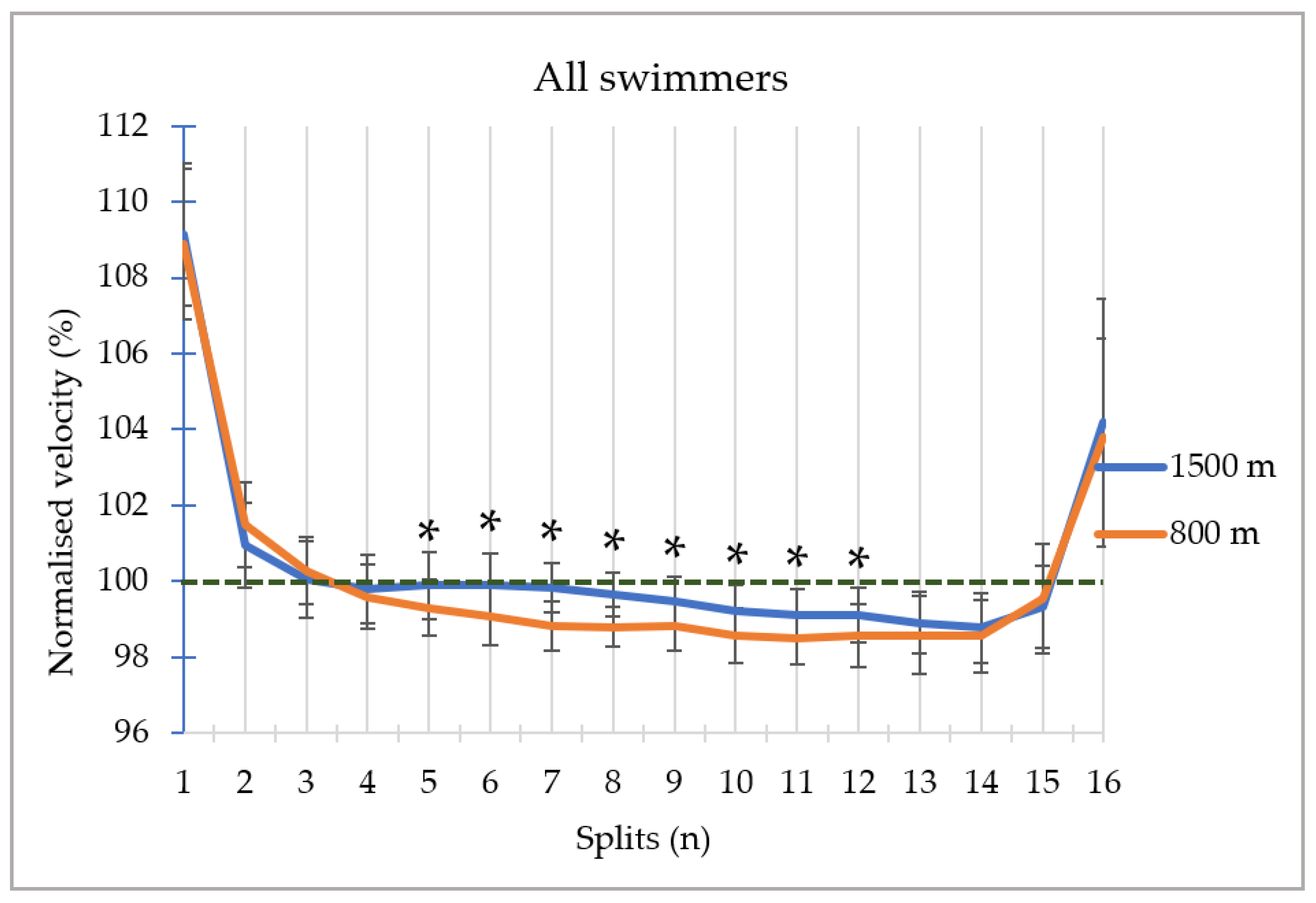
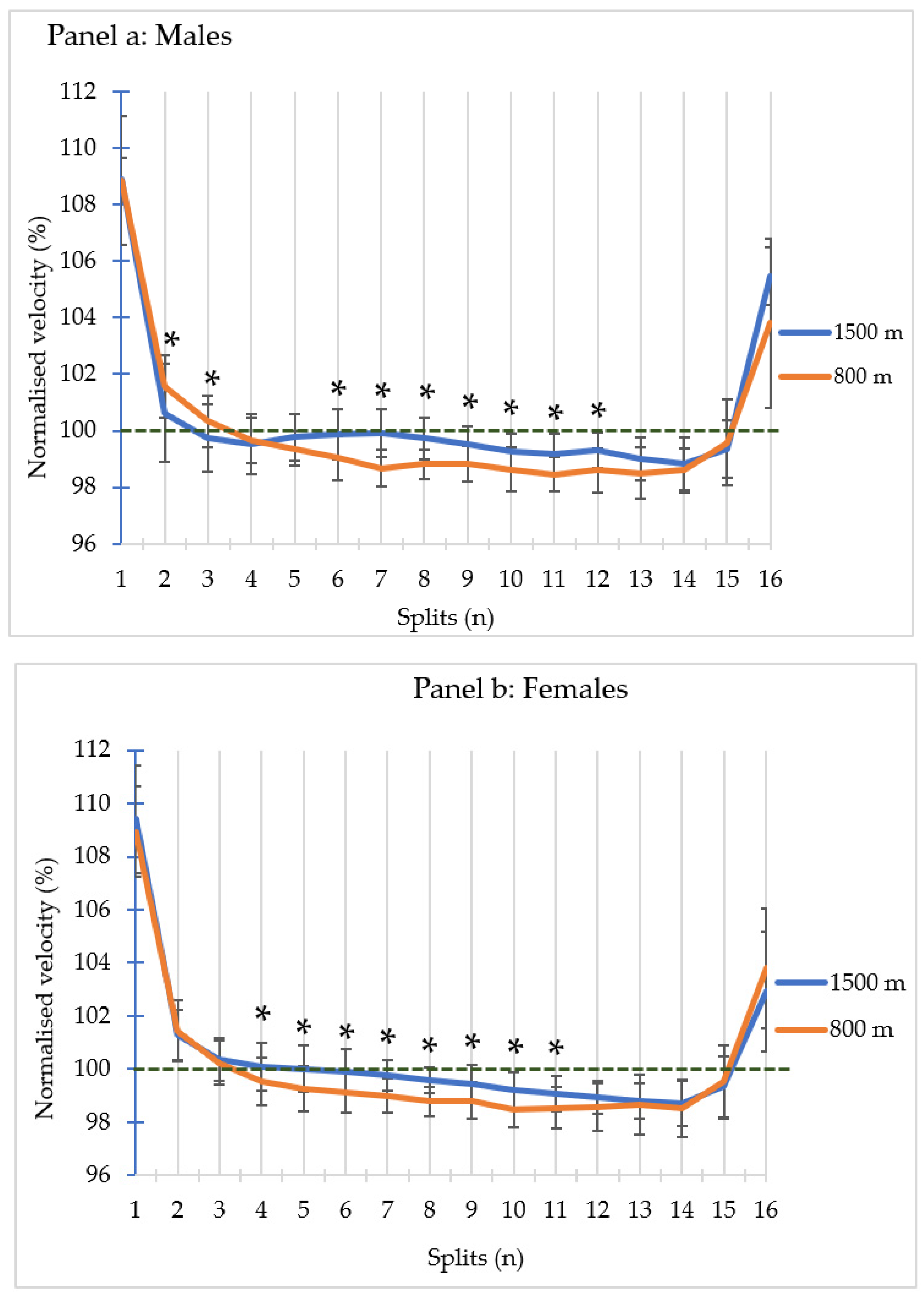
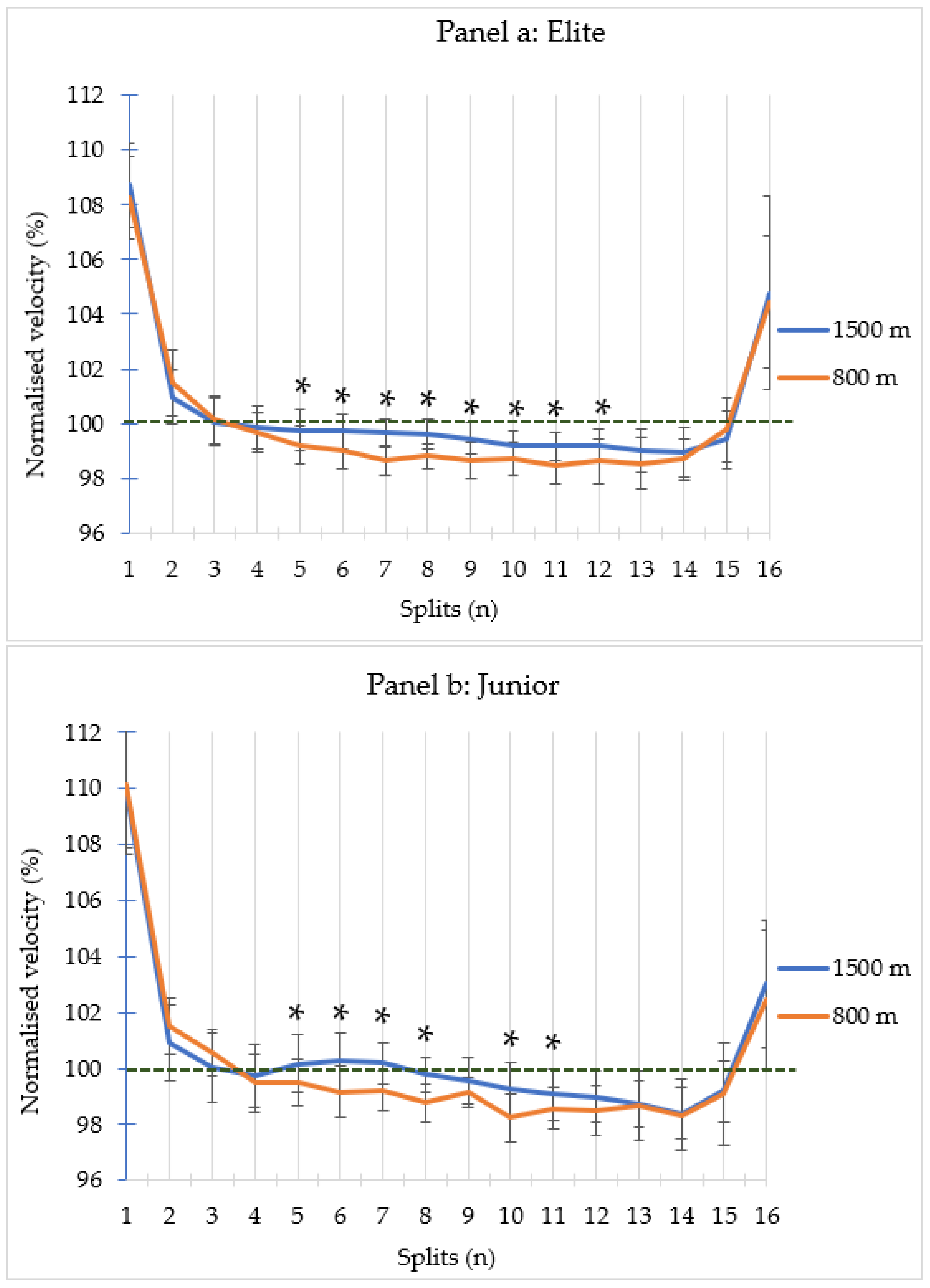
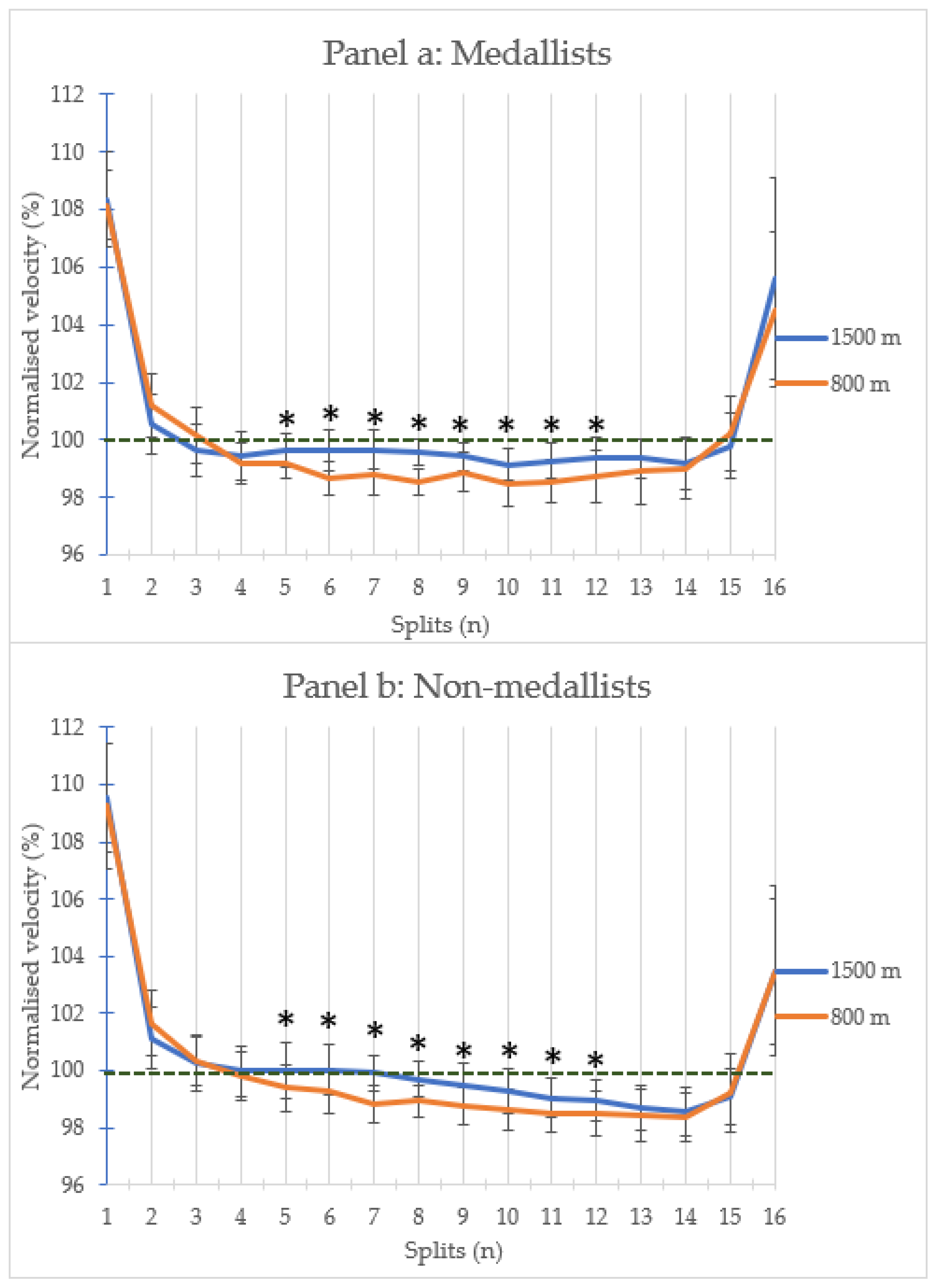
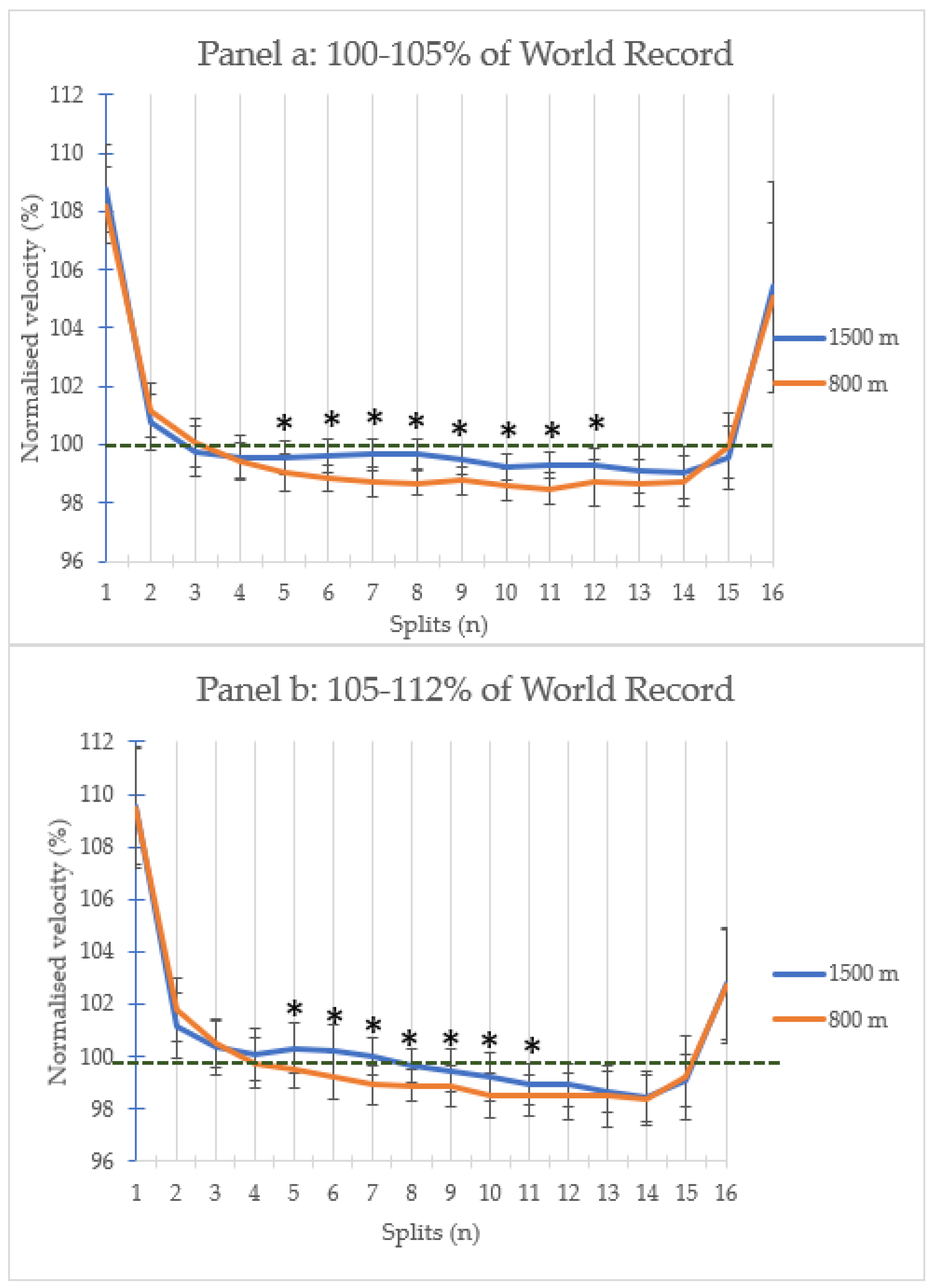
| Race Time% Record Time | |||||
|---|---|---|---|---|---|
| 1500 m | 800 m | ||||
| Subjects | n | Mean ± SD | Mean ± SD | SE | p |
| All Athletes | 96 | 105.2 ± 2.8 | 105.5 ± 2.1 | 0.1 | 0.07 |
| Males | 48 | 104.2 ± 0.0 | 106.0 ± 1.4 | 0.9 | 0.00 * |
| Females | 48 | 106.2 ± 3.0 | 104.9 ± 2.5 | 0.5 | 0.43 |
| Elite | 64 | 103.7 ± 1.6 | 104.5 ± 1.7 | 0.4 | 0.02 * |
| Junior | 32 | 108.2 ± 2.3 | 107.5 ± 1.3 | 0.4 | 0.90 |
| Medallists | 32 | 103.9 ± 2.1 | 104.5 ± 1.8 | 0.3 | 0.34 |
| Non-medallists | 64 | 105.9 ± 2.9 | 106.0 ± 2.1 | 0.0 | 0.15 |
| 100–105% of WR | 48 | 103.1 ± 1.1 | 103.6 ± 1.1 | 0.4 | 0.02 * |
| 105–112% of WR | 48 | 107.7 ± 2.1 | 107.1 ± 1.2 | 0.4 | 0.76 |
| Sequences Number (%) | Maximal Length of Sequences (%) | ||||||||
|---|---|---|---|---|---|---|---|---|---|
| 1500-m | 800-m | 1500-m | 800-m | ||||||
| Subjects | n | Mean ± SD | Mean ± SD | SE | p | Mean ± SD | Mean ± SD | SE | p |
| All Athletes | 96 | 31.3 ± 11.0 | 34.6 ± 12.8 | 0.3 | 0.00 * | 32.6 ± 9.5 | 37.6 ± 9.9 | 0.5 | 0.01 * |
| Males | 48 | 33.1 ± 0.2 | 37.2 ± 13.4 | 0.3 | 0.00 * | 28.5 ± 11.5 | 35.7 ± 10.0 | 0.7 | 0.09 |
| Females | 48 | 29.4 ± 10.5 | 32.0 ± 12.0 | 0.2 | 0.00 * | 36.7 ± 7.3 | 39.6 ± 9.7 | 0.3 | 0.07 |
| Elite | 64 | 31.7 ± 10.8 | 34.0 ± 13.1 | 0.2 | 0.00 * | 32.3 ± 9.4 | 37.3 ± 10.8 | 0.5 | 0.32 |
| Junior | 32 | 30.4 ± 11.7 | 35.9 ± 12.6 | 0.4 | 0.00 * | 33.1 ± 10.1 | 38.3 ± 8.2 | 0.5 | 0.00 * |
| Medallists | 32 | 31.7 ± 8.9 | 37.9 ± 13.6 | 0.5 | 0.00 * | 31.3 ± 8.7 | 35.2 ± 10.2 | 0.4 | 0.04 * |
| Non-medal. | 64 | 31.0 ± 33.0 | 33.0 ± 12.3 | 0.2 | 0.00 * | 33.2 ± 10.0 | 38.9 ± 9.8 | 0.6 | 0.12 |
| 100–105% | 48 | 32.4 ± 33.2 | 33.2 ± 13.0 | 0.1 | 0.00 * | 30.6 ± 9.0 | 38.1 ± 9.8 | 0.7 | 0.20 |
| 105–112% | 48 | 29.8 ± 12.8 | 35.8 ± 12.8 | 0.5 | 0.00 * | 34.8 ± 9.8 | 37.3 ± 10.2 | 0.2 | 0.04 * |
| Time Series 1—Half 2—Random 3 | CV% | ||||||||
|---|---|---|---|---|---|---|---|---|---|
| 1500-m | 800-m | 1500-m | 800-m | ||||||
| Subjects | n | Mean ± SD | Mean ± SD | SE | p | Mean ± SD | Mean ± SD | SE | p |
| All Athletes | 96 | 1.0 ± 0.1 | 1.3 ± 0.7 | 0.5 | 0.01 * | 2.9 ± 0.5 | 2.9 ± 0.6 | 0.1 | 0.60 |
| Males | 48 | 1.0 ± 2.2 | 1.4 ± 0.8 | 0.6 | 0.04 * | 2.9 ± 0.5 | 2.9 ± 0.6 | 0.0 | 0.94 |
| Females | 48 | 1.0 ± 0.0 | 1.2 ± 0.6 | 0.4 | 0.15 | 2.8 ± 0.5 | 2.9 ± 0.6 | 0.3 | 0.56 |
| Elite | 64 | 1.0 ± 0.2 | 1.4 ± 0.8 | 0.6 | 0.02* | 2.8 ± 0.5 | 2.8 ± 0.5 | 0.0 | 0.98 |
| Junior | 32 | 1.0 ± 0.0 | 1.1 ± 0.5 | 0.4 | 0.78 | 2.9 ± 0.6 | 3.1 ± 0.6 | 0.3 | 0.40 |
| Medallists | 32 | 1.0 ± 0.0 | 1.5 ± 0.9 | 0.7 | 0.24 | 2.8 ± 0.4 | 2.8 ± 0.5 | 0.0 | 0.96 |
| Non-medallists | 64 | 1.0 ± 0.2 | 1.2 ± 0.5 | 0.4 | 0.16 | 2.9 ± 0.6 | 3.0 ± 0.6 | 0.2 | 0.55 |
| 100–105% of WR | 48 | 1.0 ± 0.2 | 1.3 ± 0.7 | 0.5 | 0.20 | 2.9 ± 0.4 | 2.9 ± 0.4 | 0.1 | 0.91 |
| 105–112% of WR | 48 | 1.0 ± 0.0 | 1.3 ± 0.7 | 0.6 | 0.77 | 2.8 ± 0.6 | 3.0 ± 0.7 | 0.2 | 0.47 |
Disclaimer/Publisher’s Note: The statements, opinions and data contained in all publications are solely those of the individual author(s) and contributor(s) and not of MDPI and/or the editor(s). MDPI and/or the editor(s) disclaim responsibility for any injury to people or property resulting from any ideas, methods, instructions or products referred to in the content. |
© 2023 by the authors. Licensee MDPI, Basel, Switzerland. This article is an open access article distributed under the terms and conditions of the Creative Commons Attribution (CC BY) license (https://creativecommons.org/licenses/by/4.0/).
Share and Cite
Demarie, S.; Pycke, J.R.; Pizzuti, A.; Billat, V. Pacing Strategy of 800 m and 1500 m Freestyle Swimming Finals in the World Championships According to the Performance in Males and Females of Different Age Groups. Appl. Sci. 2023, 13, 10515. https://doi.org/10.3390/app131810515
Demarie S, Pycke JR, Pizzuti A, Billat V. Pacing Strategy of 800 m and 1500 m Freestyle Swimming Finals in the World Championships According to the Performance in Males and Females of Different Age Groups. Applied Sciences. 2023; 13(18):10515. https://doi.org/10.3390/app131810515
Chicago/Turabian StyleDemarie, Sabrina, Jean Renaud Pycke, Alessia Pizzuti, and Veronique Billat. 2023. "Pacing Strategy of 800 m and 1500 m Freestyle Swimming Finals in the World Championships According to the Performance in Males and Females of Different Age Groups" Applied Sciences 13, no. 18: 10515. https://doi.org/10.3390/app131810515
APA StyleDemarie, S., Pycke, J. R., Pizzuti, A., & Billat, V. (2023). Pacing Strategy of 800 m and 1500 m Freestyle Swimming Finals in the World Championships According to the Performance in Males and Females of Different Age Groups. Applied Sciences, 13(18), 10515. https://doi.org/10.3390/app131810515








